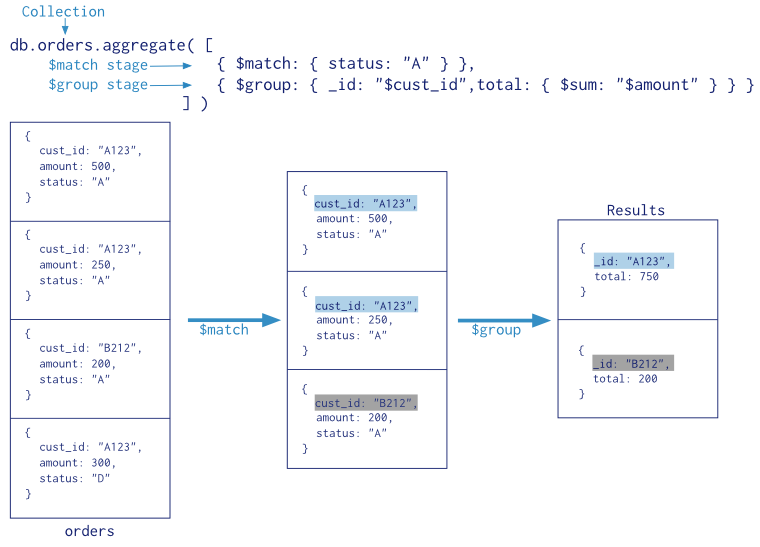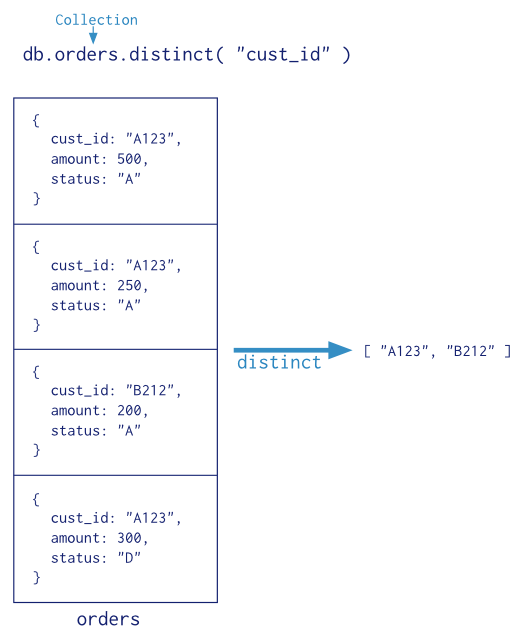Aggregation¶
On this page
Aggregations operations process data records and return computed results. Aggregation operations group values from multiple documents together, and can perform a variety of operations on the grouped data to return a single result. MongoDB provides three ways to perform aggregation: the aggregation pipeline, the map-reduce function, and single purpose aggregation methods.
You can download this section in PDF form as MongoDB Aggregation and Data Processing.
Aggregation Pipeline¶
MongoDB 2.2 introduced a new aggregation framework, modeled on the concept of data processing pipelines. Documents enter a multi-stage pipeline that transforms the documents into an aggregated result.
The most basic pipeline stages provide filters that operate like queries and document transformations that modify the form of the output document.
Other pipeline operations provide tools for grouping and sorting documents by specific field or fields as well as tools for aggregating the contents of arrays, including arrays of documents. In addition, pipeline stages can use operators for tasks such as calculating the average or concatenating a string.
The pipeline provides efficient data aggregation using native operations within MongoDB, and is the preferred method for data aggregation in MongoDB.
The aggregation pipeline can operate on a sharded collection.
The aggregation pipeline can use indexes to improve its performance during some of its stages. In addition, the aggregation pipeline has an internal optimization phase. See Pipeline Operators and Indexes and Aggregation Pipeline Optimization for details.

Map-Reduce¶
MongoDB also provides map-reduce operations to perform aggregation. In general, map-reduce operations have two phases: a map stage that processes each document and emits one or more objects for each input document, and reduce phase that combines the output of the map operation. Optionally, map-reduce can have a finalize stage to make final modifications to the result. Like other aggregation operations, map-reduce can specify a query condition to select the input documents as well as sort and limit the results.
Map-reduce uses custom JavaScript functions to perform the map and reduce operations, as well as the optional finalize operation. While the custom JavaScript provide great flexibility compared to the aggregation pipeline, in general, map-reduce is less efficient and more complex than the aggregation pipeline.
Map-reduce can operate on a sharded collection. Map reduce operations can also output to a sharded collection. See Aggregation Pipeline and Sharded Collections and Map-Reduce and Sharded Collections for details.
Note
Starting in MongoDB 2.4, certain mongo shell functions and properties are inaccessible in map-reduce operations. MongoDB 2.4 also provides support for multiple JavaScript operations to run at the same time. Before MongoDB 2.4, JavaScript code executed in a single thread, raising concurrency issues for map-reduce.

Single Purpose Aggregation Operations¶
MongoDB also provides db.collection.count(), db.collection.group(), db.collection.distinct(). special purpose database commands.
All of these operations aggregate documents from a single collection. While these operations provide simple access to common aggregation processes, they lack the flexibility and capabilities of the aggregation pipeline and map-reduce.

Additional Features and Behaviors¶
For a feature comparison of the aggregation pipeline, map-reduce, and the special group functionality, see Aggregation Commands Comparison.
Additional Resources¶
Thank you for your feedback!
We're sorry! You can Report a Problem to help us improve this page.
